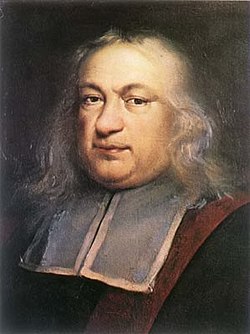Fermat's last theorem
“”I have a truly marvelous demonstration of this proposition which this margin is too narrow to contain.
|
| —Pierre de Fermat |
“”I have an elegant refutation of your attempted proof, but unfortunately this page is not large enough to contain it.
|
| —Anon |
| Part of a convergent series on Mathematics |
| 1+1=11 |
| We are number one |
Fermat's last theorem[1] states that in the equation, , if are positive integers, cannot be an integer greater than 2. Fermat wrote in the margin of a book that he had a proof of the theorem, but it would not fit in the margin. He died in 1665 before ever revealing it, and his note was discovered posthumously by his son.[2][3] Fermat must have realized that his imagined proof was flawed, because he later[When?] wrote a proof of the special case n = 4 (in which he introduced the method of proof by infinite descent).
In 1753, Euler claimed to have a proof where n=3, but this was flawed; in the early 19th century Sophie Germain, Dirichlet, and Adrien-Marie Legendre proved special cases. Gabriel Lamé claimed to have a proof in 1847 but it was shown to be incorrect. Despite a lot of interest it proved challenging even to the best minds: one study showed that in the years from 1908 and 1912, 1000 false proofs were published.[4]
In 1994, Andrew Wiles presented a proof of the theorem, using 20th century mathematical principles (modular forms, Galois theory, algebraic geometry). A mistake was discovered, which Wiles repaired after about a year of work with his former student Richard Taylor, with the final proof published in 1995. The theorem built on an earlier theorem of Ken Ribet following a program of Serre. The full modularity theorem was proved in 1998 based on the techniques of Wiles.
Crank solutions[edit]
Because it seems simple and yet was unproven for so long, and because Fermat claimed to have a simple solution, it has long been a favorite of amateur mathematicians and cranks.[5] There's a possibly apocryphal story about a visitor at the University of Chicago:
In the Math department office there were a lot of filing cabinets. One was labelled “Form Letters”. He opened it and saw a lot of folders. One folder was labelled “Fermat’s Last Theorem.” He opened it and saw a lot of identical form letters. He looked at the letter. It began: “Dear Sir, We have received your proof of Fermat’s Last Theorem…” There were other folders, like “Goldbach’s Conjecture”, “Angle Trisecting”, etc. Each of the form letters offered to have a graduate student examine the claimed proof for $50, up to finding the first error or non sequitur. Even for $50, graduate students were reluctant to do this work because the “proofs” were generally indecipherable.[6]
Even after Wiles's success, the ill-conceived attempts at a simpler proof continued.[7] For instance, in 2005 a Russian professor claimed to have a 3-line proof.[8] There has even been hoax reports that Wiles's solution had been disproved, such as one in Manila in 2005, possibly intended to give succor to wannabe solvers.[8]
See also[edit]
References[edit]
- ↑ Singh, Simon (1997). Fermat's Last Theorem. Fourth Estate. ISBN 1-85702-669-1.
- ↑ http://www-groups.dcs.st-and.ac.uk/~history/HistTopics/Fermat's_last_theorem.html
- ↑ http://www.simonsingh.net/Fermat_Corner.html
- ↑ Fermat's Last Theorem, J J O'Connor and E F Robertson, Maths History, St Andrews Uni, 1996
- ↑ Review: Riddle of the curves, Richard Pinch, 1999
- ↑ What kind of math "crank" proofs have you gotten from amateur mathematicians?, David Grossman, Quora, 2019
- ↑ Fermat, Crank.net
- ↑ 8.0 8.1 Another False Proof: Russian Professor claims to have solved Fermat's Last Theorem, Larry Freeman, Fermat's Last Theorem blog, Aug 24, 2005



